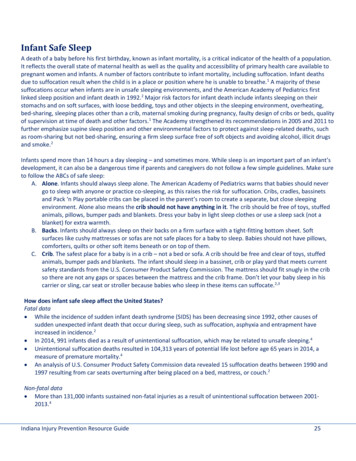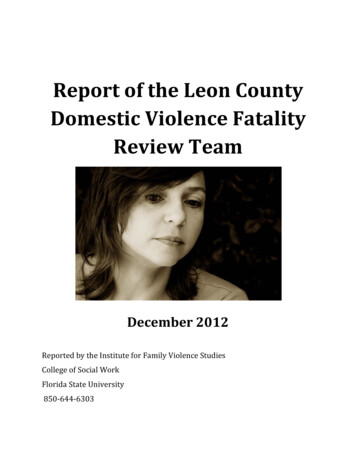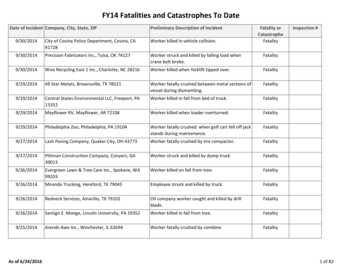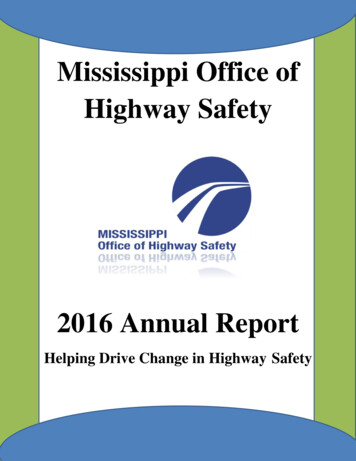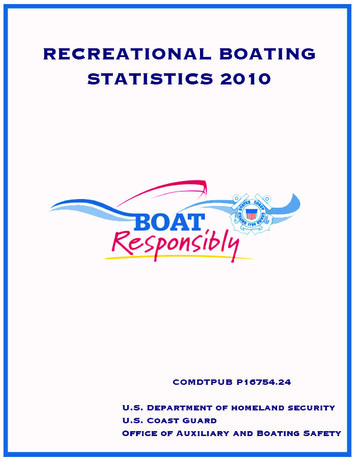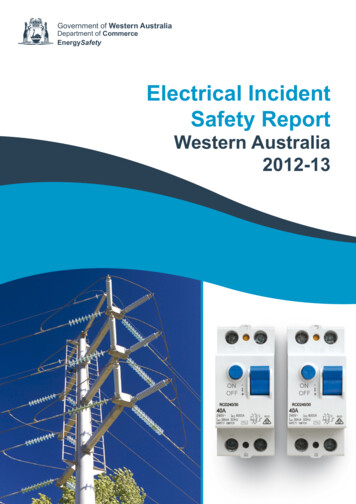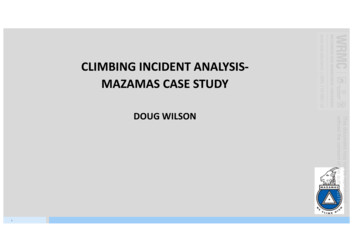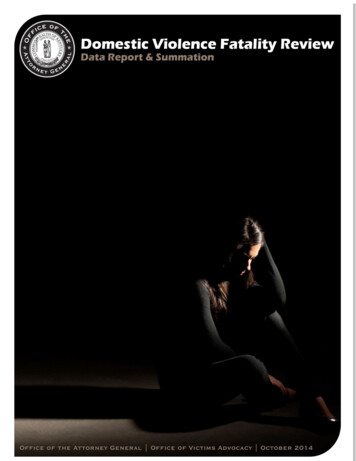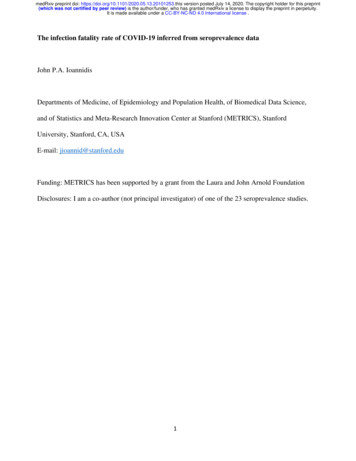
Transcription
medRxiv preprint doi: https://doi.org/10.1101/2020.05.13.20101253.this version posted July 14, 2020. The copyright holder for this preprint(which was not certified by peer review) is the author/funder, who has granted medRxiv a license to display the preprint in perpetuity.It is made available under a CC-BY-NC-ND 4.0 International license .The infection fatality rate of COVID-19 inferred from seroprevalence dataJohn P.A. IoannidisDepartments of Medicine, of Epidemiology and Population Health, of Biomedical Data Science,and of Statistics and Meta-Research Innovation Center at Stanford (METRICS), StanfordUniversity, Stanford, CA, USAE-mail: jioannid@stanford.eduFunding: METRICS has been supported by a grant from the Laura and John Arnold FoundationDisclosures: I am a co-author (not principal investigator) of one of the 23 seroprevalence studies.1
medRxiv preprint doi: https://doi.org/10.1101/2020.05.13.20101253.this version posted July 14, 2020. The copyright holder for this preprint(which was not certified by peer review) is the author/funder, who has granted medRxiv a license to display the preprint in perpetuity.It is made available under a CC-BY-NC-ND 4.0 International license .ABSTRACTObjective To estimate the infection fatality rate of coronavirus disease 2019 (COVID-19) fromdata of seroprevalence studies.Methods Population studies with sample size of at least 500 and published as peer-reviewedpapers or preprints as of July 11, 2020 were retrieved from PubMed, preprint servers, andcommunications with experts. Studies on blood donors were included, but studies on healthcareworkers were excluded. The studies were assessed for design features and seroprevalenceestimates. Infection fatality rate was estimated from each study dividing the number of COVID-19deaths at a relevant time point by the number of estimated people infected in each relevant region.Correction was also attempted accounting for the types of antibodies assessed. Secondarily,results from national studies were also examined from preliminary press releases and reportswhenever a country had no other data presented in full papers of preprints.Results 36 studies (43 estimates) were identified with usable data to enter into calculations andanother 7 preliminary national estimates were also considered for a total of 50 estimates.Seroprevalence estimates ranged from 0.222% to 47%. Infection fatality rates ranged from 0.00%to 1.63% and corrected values ranged from 0.00% to 1.31%. Across 32 different locations, themedian infection fatality rate was 0.27% (corrected 0.24%). Most studies were done in pandemicepicenters with high death tolls. Median corrected IFR was 0.10% in locations with COVID-19population mortality rate less than the global average ( 73 deaths per million as of July 12, 2020),0.27% in locations with 73-500 COVID-19 deaths per million, and 0.90% in locations exceeding500 COVID-19 deaths per million. Among people 70 years old, infection fatality rates rangedfrom 0.00% to 0.57% with median of 0.05% across the different locations (corrected median of0.04%).2
medRxiv preprint doi: https://doi.org/10.1101/2020.05.13.20101253.this version posted July 14, 2020. The copyright holder for this preprint(which was not certified by peer review) is the author/funder, who has granted medRxiv a license to display the preprint in perpetuity.It is made available under a CC-BY-NC-ND 4.0 International license .Conclusions The infection fatality rate of COVID-19 can vary substantially across differentlocations and this may reflect differences in population age structure and case-mix of infected anddeceased patients as well as multiple other factors. Estimates of infection fatality rates inferredfrom seroprevalence studies tend to be much lower than original speculations made in the earlydays of the pandemic.3
medRxiv preprint doi: https://doi.org/10.1101/2020.05.13.20101253.this version posted July 14, 2020. The copyright holder for this preprint(which was not certified by peer review) is the author/funder, who has granted medRxiv a license to display the preprint in perpetuity.It is made available under a CC-BY-NC-ND 4.0 International license .The infection fatality rate (IFR), the probability of dying for a person who is infected, isone of the most critical and most contested features of the coronavirus disease 2019 (COVID-19)pandemic. The expected total mortality burden of COVID-19 is directly related to the IFR.Moreover, justification for various non-pharmacological public health interventions dependscrucially on the IFR. Some aggressive interventions that potentially induce also more pronouncedcollateral harms1 may be considered appropriate, if IFR is high. Conversely, the same measuresmay fall short of acceptable risk-benefit thresholds, if the IFR is low.Early data from China, adopted also by the World Health Organization (WHO),2 focusedon a crude case fatality rate (CFR) of 3.4%; CFR is the ratio of COVID-19 deaths divided by thenumber of documented cases, i.e. patients with symptoms who were tested and found to be PCRpositive for the virus. The WHO envoy who visited China also conveyed the message that thereare hardly any asymptomatic infections.3 With a dearth of asymptomatic infections, the CFRapproximates the IFR. Other mathematical models suggested that 40-70%,4 or even5 81% of theglobal population would be infected. Influential mathematical models5,6 eventually dialed back toan IFR of 1.0% or 0.9%, and these numbers long continued to be widely cited and used in bothpublic and scientific circles. The most influential of these models, constructed by Imperial Collegeestimated 2.2 million deaths in the USA and over half a million deaths in the UK in the absence oflockdown measures.5 Such grave predictions justifiably led to lockdown measures adopted inmany countries. With 0.9% assumed infection fatality rate and 81% assumed proportion of peopleinfected, the prediction would correspond to a global number of deaths comparable with the 1918influenza, in the range of 50 million fatalities.Since late March 2020, many studies have tried to estimate the extend of spread of thevirus in various locations by evaluating the seroprevalence, i.e. how many people in populationsamples have developed antibodies for the virus. These studies can be useful because they may4
medRxiv preprint doi: https://doi.org/10.1101/2020.05.13.20101253.this version posted July 14, 2020. The copyright holder for this preprint(which was not certified by peer review) is the author/funder, who has granted medRxiv a license to display the preprint in perpetuity.It is made available under a CC-BY-NC-ND 4.0 International license .inform about the extend of under-ascertainment of documenting the infection based on PCRtesting. Moreover, they can help obtain estimates about the IFR, since one can divide the numberof observed deaths by the estimated number of people who are inferred to have been infected.At the same time, seroprevalence studies may have several caveats in their design,conduct, and analysis that may affect their results and their interpretation. Here, data available asof July 11, 2020 were collected, scrutinized, and used to infer estimates of IFR in differentlocations where these studies have been conducted.METHODSSeroprevalence studiesThe input data for the calculations of IFR presented here are studies of seroprevalence ofCOVID-19 that have been done in the general population, or in samples that might approximatethe general population (e.g. with proper reweighting) and that have been published in peerreviewed journals or have been submitted as preprints as of July 11, 2020. Only studies with atleast 500 assessed samples were considered, since smaller datasets would entail extremely largeuncertainty for any calculations to be based on them. When studies focused on makingseroprevalence assessments at different time interval, they were eligible if at least one timeinterval assessment had a sample size of at least 500 participants; among different eligible timepoints, the one with the highest seroprevalence was selected, since seroprevalence may decreaseover time as antibody titers wane. Studies with data collected over more than a month, and thatcould not be broken into at least one eligible time interval that did not exceed one month induration were excluded, since it would not be possible to estimate a point seroprevalence with anyreliability. Studies were eligible regardless of the exact age range of included participants, butstudies including only children were excluded.5
medRxiv preprint doi: https://doi.org/10.1101/2020.05.13.20101253.this version posted July 14, 2020. The copyright holder for this preprint(which was not certified by peer review) is the author/funder, who has granted medRxiv a license to display the preprint in perpetuity.It is made available under a CC-BY-NC-ND 4.0 International license .Studies where results were only released through press releases were not considered here,since it is very difficult to tell much about their design and analysis, and this is fundamental inmaking any inferences based on their results. Nevertheless, secondarily, results from nationalstudies were also examined from preliminary press releases and reports whenever a country hadno other data presented in full papers of preprints as of July 11, 2020. This allowed these countriesto be represented in the collected data, but extra caution is required given the preliminary nature ofthis information. Preprints should also be seen with caution since they have not been yet fullypeer-reviewed (although some of them have already been revised based on very extensivecomments from the scientific community). However, in contrast to press releases, preprintstypically offer at least a fairly complete paper with information about design and analysis.Studies done of blood donors were eligible, although it is possible they may underestimateseroprevalence and overestimate IFR due to healthy volunteer effect. Studies done on health careworkers were not eligible, since they deal with a group at potentially high exposure risk whichmay lead to seroprevalence estimates much higher than the general population and thusimplausibly low IFR. For a similar reason, studies focused on communities (e.g. shelters orreligious or other shared-living communities) were also excluded. Studies were eligible regardlessof whether they aimed to evaluate seroprevalence in large or small regions, provided that thepopulation of reference in the region was at least 5000 people.Searches were made in PubMed (LitCOVID), medRxiv, bioRxiv, and Research Squareusing the terms “seroprevalence” and “antibodies” with continuous updates (last update July 11,2020). Communication with colleagues who are field experts sought to ascertain if any majorstudies might have been missed.Information was extracted from each study on location, recruitment and sampling strategy,dates of sample collection, sample size, types of antibody used (IgG, IgM, IgA), estimated crude6
medRxiv preprint doi: https://doi.org/10.1101/2020.05.13.20101253.this version posted July 14, 2020. The copyright holder for this preprint(which was not certified by peer review) is the author/funder, who has granted medRxiv a license to display the preprint in perpetuity.It is made available under a CC-BY-NC-ND 4.0 International license .seroprevalence (positive samples divided by all samples test), and adjusted seroprevalence andfeatures that were considered in the adjustment (sampling process, test performance, presence ofsymptoms, other).Calculation of inferred IFRInformation on the population of the relevant location was collected from the papers.Whenever it was missing, it was derived based on recent census data trying to approximate asmuch as possible the relevant catchment area (e.g. region(s) or county(ies)), whenever the studydid not pertain to an entire country. Some studies targeted specific age groups (e.g. excludingelderly people and/or excluding children) and some of them made inferences on number of peopleinfected in the population based on specific age groups. For consistency, the entire population, aswell as, separately, only the population with age 70 years were used for estimating the number ofinfected people. It was assumed that the seroprevalence would be similar in different age groups,but significant differences in seroprevalence according to age strata that had been noted by theoriginal authors were also recorded to examine the validity of this assumption.The number of infected people was calculated multiplying the relevant population with theadjusted estimate of seroprevalence. Whenever an adjusted seroprevalence estimate had not beenobtained, the unadjusted seroprevalence was used instead. When seroprevalence estimates withdifferent adjustments were available, the analysis with maximal adjustment was selected.For the number of COVID-19 deaths, the number of deaths recorded at the time chosen bythe authors of each study was selected, whenever the authors used such a death count up to aspecific date to make inferences themselves. If the choice of date had not been done by theauthors, the number of deaths accumulated until after 1 week of the mid-point of the study periodwas chosen. This accounts for the differential delay in developing antibodies versus dying fromthe infection. It should be acknowledged that this is an averaging approximation, because some7
medRxiv preprint doi: https://doi.org/10.1101/2020.05.13.20101253.this version posted July 14, 2020. The copyright holder for this preprint(which was not certified by peer review) is the author/funder, who has granted medRxiv a license to display the preprint in perpetuity.It is made available under a CC-BY-NC-ND 4.0 International license .patients may die very soon (within 3 weeks) after infection (and thus are overcounted), andothers may die very late (and thus are undercounted due to right censoring).The inferred IFR was obtained by dividing the number of deaths by the number of infectedpeople for the entire population, and separately for people 70 years old. The proportion ofCOVID-19 deaths that occurred in people 70 years old was retrieved from situational reports forthe respective countries, regions, or counties in searches done in June 3-7 for studies publisheduntil June 7 and in July 3-11 for studies published later. A corrected IFR is also presented, tryingto account for the fact that only one or two types of antibodies (among IgG, IgM, IgA) might havebeen used. Correcting seroprevalence upwards (and inferred IFR downwards) by 1.1-fold for notperforming IgM measurements and similarly for not performing IgA measurements may bereasonable, based on some early evidence,7 although there is uncertainty about the exact correctionfactor.Data synthesis considerationsInspection of the IFR estimates across all locations showed vast heterogeneity withheterogeneity I2 exceeding 99.9% and thus a meta-analysis would be inappropriate to report acrossall locations. Quantitative synthesis with meta-analysis across all locations would also bemisleading since locations with high seroprevalence would tend to carry more weight thanlocations with low seroprevalence; locations with more studies (typically those that have attractedmore attention because of high death tolls and thus high IFRs) would be represented multipletimes in the calculations; and more sloppy studies with fewer adjustments would get more weight,because they would have spuriously tighter confidence intervals than more rigorous studies withmore careful adjustments allowing for more uncertainty. Finally, with a highly skewed IFRdistribution and with extreme between-study heterogeneity, synthesis with a typical randomeffects model would tend to produce an erroneously high summary IFR that approximates the8
medRxiv preprint doi: https://doi.org/10.1101/2020.05.13.20101253.this version posted July 14, 2020. The copyright holder for this preprint(which was not certified by peer review) is the author/funder, who has granted medRxiv a license to display the preprint in perpetuity.It is made available under a CC-BY-NC-ND 4.0 International license .mean of the study-specific estimates (also heavily driven by hotbed high-mortality locations withmore studies done), while for a skewed distribution the median is more appropriate.Therefore, at a first step, IFR estimates from studies done in the same country (or in theUS, the same state) were grouped together and a single IFR was obtained for that location,weighting the study-specific IFRs by the sample size of each study. This allowed to avoid givinginappropriately more weight to studies with higher seroprevalence estimates and those withseemingly tighter confidence intervals because of poor or no adjustments, while still giving moreweight to larger studies. Then, a single summary estimate was used for each location and themedian of the distribution of location-specific IFR estimates was calculated. Finally, it wasexplored whether the location-specific IFRs were associated with the COVID-19 mortality rate inthe population (COVID-19 deaths per million people) in each location as of July 12, 2020; thisallowed to assess whether IFR estimates tend to be higher in harder hit locations.RESULTSSeroprevalence studies36 studies with a total of 43 eligible estimates were published either in the peer-reviewedliterature or as preprints as of July 11, 2020.8-43 Dates and processes of sampling and recruitmentare summarized in Table 1, sample sizes, antibody types assessed and regional population appearin Table 2, estimated prevalence, and number of people infected in the study region aresummarized in Table 3, and number of COVID-19 and inferred IFR estimates are found in Table4. Several studies performed repeated seroprevalence surveys at different time points, and only thetime point with the highest seroprevalence estimate is considered in the calculations. With threeexceptions, this is also the latest time point. Furthermore, another 7 preliminary national estimateswere also considered (Table 5)44-50 from countries that had no other seroprevalence studypublished as a full paper or preprint. This yielded a total of 50 eligible estimates.9
medRxiv preprint doi: https://doi.org/10.1101/2020.05.13.20101253.this version posted July 14, 2020. The copyright holder for this preprint(which was not certified by peer review) is the author/funder, who has granted medRxiv a license to display the preprint in perpetuity.It is made available under a CC-BY-NC-ND 4.0 International license .At least seven studies found some statistically significant, modest differences inseroprevalence rates across some age groups (Oise: decreased seroprevalence in age 0-14,increased in age 15-17; Geneva: decreased seroprevalence in age 50; Netherlands: increasedseroprevalence in age 18-30; New York state: decreased seroprevalence in age 55; Brooklyn:decreased seroprevalence in age 0-5, increased in age 16-20; Tokyo: increased seroprevalence inage 18-34, Spain: decreased seroprevalence in age 0-10, Belgium: higher seroprevalence in age 90). The patterns are not strong enough to suggest major differences in extrapolating across agegroups, although higher values in adolescents and young adults and lower values in childrencannot be excluded.As shown in Table 1, these studies varied substantially in sampling and recruitmentdesigns. The main issue is whether they can offer a representative picture of the population in theregion where they are performed. A generic problem is that vulnerable people who are at high riskof infection and/or death may be more difficult to recruit in survey-type studies. COVID-19infection seems to be particularly widespread and/or lethal in nursing homes, among homelesspeople, in prisons, and in disadvantaged minorities. Most of these populations are very difficult, oreven impossible to reach and sample from and they are probably under-represented to variousdegrees (or even entirely missed) in surveys. This would result in an underestimation ofseroprevalence and thus overestimation of IFR. Eleven of the 36 studies that are available as fullpapers (Iran,8 Geneva,10 Gangelt,16 Rio Grande do Sul,17 Luxembourg,20 Los Angeles county,22three Brazil studies,25,34,42, Spain,36 and Louisiana37) explicitly aimed for random sampling fromthe general population. In principle, this is a stronger design. However, even with such designs,people who cannot be reached (e.g. by e-mail or phone or even visiting them at a house location)will not be recruited, and these vulnerable populations are likely to be missed. Moreover, 5 ofthese 11 studies8,10,16,42,37 focused on studying geographical locations that had extreme numbers of10
medRxiv preprint doi: https://doi.org/10.1101/2020.05.13.20101253.this version posted July 14, 2020. The copyright holder for this preprint(which was not certified by peer review) is the author/funder, who has granted medRxiv a license to display the preprint in perpetuity.It is made available under a CC-BY-NC-ND 4.0 International license .deaths, higher than other locations in the same city or country, and this would tend to selecteventually for higher IFR on average.Seven studies assessed blood donors in Denmark,12 Netherlands,15 Scotland,18 the BayArea in California,24 Zurich/Lucerne,28 Apulia31 and Rio De Janeiro.41 By definition these studiesinclude people in good health and without symptoms, at least recently, and therefore maymarkedly underestimate COVID-19 seroprevalence in the general population. A small set of 200blood donors in Oise, France13 showed 3% seroprevalence, while pupils, siblings, parents,teachings and staff at a high school with a cluster of cases in the same area had 25.9%seroprevalence; true population seroprevalence may be between these two values.For the other studies, healthy volunteer bias may lead to underestimating seroprevalenceand this is likely to have been the case in at least one case (the Santa Clara study)19 where wealthyhealthy people were rapidly interested to be recruited when the recruiting Facebook ad wasreleased. The design of the study anticipated correction with adjustment of the sampling weightsby zip code, gender, and ethnicity, but it is likely that healthy volunteer bias may still have led tosome underestimation of seroprevalence. Conversely, attracting individuals who might have beenconcerned of having been infected (e.g. because they had symptoms) may lead to overestimationof seroprevalence in surveys. Finally studies of employees, grocery store clients, or patient cohorts(e.g. hospitalized for other reasons, or coming to the emergency room, or studies using residuallab samples) may have sampling bias with unpredictable direction.As shown in Table 2, all studies have tested for IgG antibodies, but only about half havealso assessed IgM, 4 have assessed IgA. Only three studies assessed all three types of antibodiesand one more used a pan-Ig antibody. Studies typically considered the results to be “positive” ifany tested antibody type was positive, but one study (Luxembourg) that considered the results tobe “positive” only if both IgG and IgA were detected. The ratio of people sampled versus the total11
medRxiv preprint doi: https://doi.org/10.1101/2020.05.13.20101253.this version posted July 14, 2020. The copyright holder for this preprint(which was not certified by peer review) is the author/funder, who has granted medRxiv a license to display the preprint in perpetuity.It is made available under a CC-BY-NC-ND 4.0 International license .population of the region was better than 1:1000 in 11 studies (Idaho,9 Denmark blood donors,12Gangelt,16 Santa Clara,19 Luxembourg,20 Brooklyn,27 Zurich,28 San Francisco,33 Espirito Santo,34Spain,36 and Vitacura43).Seroprevalence estimatesAs shown in Table 3, prevalence ranged from as little as 0.222% to as high as 47%.Studies varied a lot on whether they tried or not to adjust their estimates for test performance,sampling (striving to get closer to a more representative sample), and clustering effects (e.g. whenincluding same household members) as well as other factors. The adjusted seroprevalenceoccasionally differed substantially from the crude, unadjusted value. In principle adjusted valuesare likely to be closer to the true estimate, but the exercise shows that each study alone may havesome unavoidable uncertainty and fluctuation, depending on the analytical choices preferred. Instudies that sampled people from multiple locations, large between-location heterogeneity couldbe seen (e.g. 0-25% across 133 Brazilian cities).25Inferred IFRInferred IFR estimates varied a lot, from 0.00% to 1.63%. Corrected values also variedextensively, from 0.00% to 1.31%. For 10 locations, more than one IFR estimate was availableand thus IFR from different studies evaluating the same location could be compared. As shown infigure 1, the IFR estimates tended to be more homogeneous within each location, while theydiffered a lot across locations. The sample size-weighted summary was used to generate a singleestimate to represent each location. Data were available for 32 different locations. The median IFRacross all 32 locations was 0.27% (0.24% using the corrected values). Most data came fromlocations with high death tolls and 23 of the 32 locations had a population mortality rate (deathsper million population) higher than the global average (73 deaths per million population as of July12) (Figure 2). The uncorrected IFR estimates had a range of 0.01-0.16% (median 0.13%) across12
medRxiv preprint doi: https://doi.org/10.1101/2020.05.13.20101253.this version posted July 14, 2020. The copyright holder for this preprint(which was not certified by peer review) is the author/funder, who has granted medRxiv a license to display the preprint in perpetuity.It is made available under a CC-BY-NC-ND 4.0 International license .the 9 locations with population mortality rate below the global average, 0.07-0.73% (median0.27%) across the 15 locations with population mortality rate above the global average but below500 deaths per million population, and 0.59-1.63% (median 1.12%) across the 8 extreme hotbedlocations with over 500 deaths per million population. The corrected IFR estimates had mediansof 0.10%, 0.25%, and 0.90%, respectively, for the three groups of locations.The proportion of COVID-19 deaths that occurred in people 70 years old variedsubstantially across locations. All deaths in Gangelt were in elderly people while in Wuhan halfthe deaths occurred in people 70 years old and the proportion might have been higher in Iran, butno data could be retrieved for this country. When limited to people 70 years old, IFR rangedfrom 0.00% to 0.57% with median of 0.05% (corrected, 0.00-0.46% with median of 0.04%). IFRestimates in people 70 years old were lower than 0.1% in all but 7 locations that were hard-hithotbeds (Belgium, Wuhan, Italy, Spain, Connecticut, Louisiana, New York).DISCUSSIONIFR is not a fixed physical constant and it can vary substantially across locations,depending on the population structure, the case-mix of infected and deceased individuals andother, local factors. Inferred IFR values based on emerging seroprevalence studies typically showa much lower fatality than initially speculated in the earlier days of the pandemic.The studies analyzed here represent 50 different estimates of IFR, but they are not fullyrepresentative of all countries and locations around the world. Most of them come from locationswith overall COVID-19 mortality rates exceeding the global average (73 deaths per million peopleas of July 12). The median inferred IFR in locations with COVID-19 mortality rate below theglobal average is low (0.13%, corrected 0.10%). For hotbed countries with COVID-19 mortalityrates above the global average but lower than 500 deaths per million, the median IFR is still notthat high (median 0.27%, corrected 0.25%). Very high IFR estimates have been documented13
medRxiv preprint doi: https://doi.org/10.1101/2020.05.13.20101253.this version posted July 14, 2020. The copyright holder for this preprint(which was not certified by peer review) is the author/funder, who has granted medRxiv a license to display the preprint in perpetuity.It is made available under a CC-BY-NC-ND 4.0 International license .practically in locations that had devastating experiences with COVID-19. Such epicenters areunusual across the globe, but they are overrepresented in the 50 seroprevalence estimates availablefor this analysis. Therefore, if one could sample equally from all countries and locations aroundthe globe, the median IFR might be even lower than the one observed in the current analysis.Several studies in hard-hit European countries inferred modestly high IFR estimates for theoverall population, but the IFR was still low in people 70 years old. Some of these studies wereon blood donors and may have underestimated seroprevalence and overestimated IFR. One studyin Germany aimed to test the entire population of a city and thus selection bias is minimal:Gangelt16 represents a situation with a superspreader event (in a local carnival) and 7 deaths wererecorded, all of them in very elderly individuals (average age 81, sd 3.5). COVID-19 has a verysteep age gradient of death risk.51 It is expected therefore that in locations where the infectionfinds its way into killing predominantly elderly citizens, the overall, age-unadjusted IFR would behigher. However, IFR would still be very low in people 70 in these locations, e.g. in Gangelt IFRis 0.00% in non-elderly people. Similarly, in Switzerland, 69% of deaths occurred in people 80years old51 and this explains the relatively high overall IFR in Geneva and Zurich. Similar toGermany, very few deaths in Switzerland have been recorded in non-elderly people, e.g. only2.5% have
2 ABSTRACT Objective To estimate the infection fatality rate of coronavirus disease 2019 (COVID-19) from data of seroprevalence studies. Methods Population studies with sample size of at least 500 and published as peer-reviewed papers or preprints as of July 11, 2020 were retrieved from PubMed, preprint servers, and


